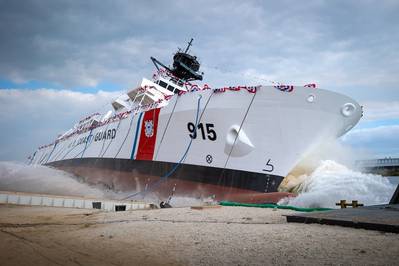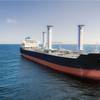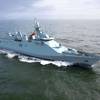USCG's New Cutters Can’t Arrive Soon Enough
The much-needed replacement for the U.S. Coast Guard’s long-serving medium endurance cutters (WMEC) took a giant step closer to joining the fleet as the first Offshore Patrol Cutter (OPC) was launched and christened at Eastern Shipbuilding Group (ESG) in Panama City, Fla. on October 27, 2023.
The future USCGC Argus (WMSM 915) was christened by the ship’s sponsor, Captain (Ret.) Beverly Kelley, the first woman to command a U.S. military vessel, the 95-foot patrol boat, USCGC Cape Newagen (WPB 95318). She later became the first woman to command a medium endurance cutter, USCGC Northland (WMEC 904), and then a high endurance cutter, USCGC Boutwell (WHEC 719). Kelley retired from the Coast Guard in 2006.
Delivering the keynote address at the Oct. 27 ceremony, Commandant of the Coast Guard Adm. Linda Fagan, called the OPC a “game-changer for the Coast Guard and for the nation. Demand for Coast Guard missions – and cutters that execute them – has never been higher and that demand is global, and this ship will contribute to helping ensure maritime governance and sovereignty across the world.”
The Coast Guard plans to procure up to 25 of the 360-foot, 3,700-ton OPCs. Along with the Polar Security Cutter (PSC) program, the Coast Guard officials describes the OPC program as one of the service’s highest acquisition priorities.
Despite the faithful service, the WMEC fleet is in desperate need of recapitalization. The Reliance-class medium endurance cutters are 210 feet long and have a full load displacement of about 1,100 tons. Fifteen were built. The first, USCGC Reliance (WMEC 615) was commissioned in 1964, and 12 are still active in the fleet (three have been decommissioned, and two of those serve today in Sri Lanka and Colombia). The newest, USCGC Alert (WMEC 630), was commissioned in 1969. The Famous-class medium endurance cutters are 270 feet long and have a full load displacement of about 1,800 tons. The lead ship, USCGC Bear (WMEC 901), was commissioned in 1983, making her 40 years old. The newest, USCGC Mohawk (WMEC 913), joined the fleet in 1991. All 13 of them are still active. The 282-foot, 3,400-ton USCGC Alex Haley (WMEC 39) is a repurposed former Navy Edenton-class towing and salvage ship that served between 1971 and 1996, and was commissioned into Coast Guard service in 1991. She is the only ship of her class in the Coast Guard inventory.
According to the “Coast Guard Cutter Procurement: Background and Issues for Congress Updated October 19, 2023,” report from the Congressional Research Service, “Many of these 90 ships are manpower-intensive and increasingly expensive to maintain, and have features that in some cases are not optimal for performing their assigned missions.”
The OPC joins the 11 planned 418-foot National Security Cutters, nine of which are in service, which are the replacements for the 378-foot Hamilton-class high-endurance cutters (the last of which left service in 2021), and the planned 65 154-foot Fast Response Cutters, of which 54 are active, which are replacing the 110-foot Island-class patrol boats.
According to Coast Guard spokesman Brian Olexy, the three new classes of “white hull” cutters, the NSC, OPC and FRC, deliver a spectrum of capability. “The FRC has shorter endurance, but is very versatile. The NSC is built for extended patrols in remote areas, like the Bering Sea, and operational command and control functions. The OPC complements both of those profiles; it can get out there in the offshore environment and stay there.”
The OPC will accommodate a crew of up to 126—compared with the 270s and 210s with crews of 100 and 75 respectively--and are capable of eight-week patrols. OPCs will have a rage of 10,200 nautical miles at 14 knots.
“Seventy percent of the Coast Guard’s offshore presence will be provided by OPCs,” Olexy said.
The OPC will also be better able to operate with the Navy and other partners. They will be capable of deploying independently or integrated as part of task groups and serving as a mobile command and control platform for surge operations such as hurricane response, mass migration incidents and other events. The cutters will also conduct operations in the Arctic by helping regulate and protect emerging commerce, support fisheries enforcement and energy exploration in Alaska.
“The OPC will have the ability to exchange voice, data, and video with other Coast Guard assets, as well as U.S. Navy aircraft and ships and U.S. government partners, as well as commercial and private aircraft and vessels. The OPC will also have facilities to communicate and share data with NATO and international partners,” Olexy said.
 (Image: Eastern Shipbuilding Group)
(Image: Eastern Shipbuilding Group)
The OPC is based on the Vard Marine Inc., VARD 7 110 Offshore Patrol Vessel design. Vard has been working with ESG on the OPC program for the past 11 years, beginning with concept design and continuing through the preliminary and contract design phases, as well as detail design and construction.
Northrop Grumman is the system integrator for the C4ISR and control systems, which includes the integrated bridge, navigation, command and control, computing network, data distribution, machinery control, and propulsion control system. The OPC is armed with the BAE Systems MK 110 57 mm gun, which is the same gun found on the NSC and the U.S. Navy’s littoral combat ships. Like the NSC, the OPC has a flight deck to accommodate helicopters and unmanned aerial systems. However, while the NSC and FRC have stern ramps to launch and recover their interceptor boats, the OPC uses over-the-side davit cranes for launch and recovery.
The first four OPCs are being built by ESG at Panama City. The lead ship is expected to be delivered to the Coast Guard towards the end of fiscal year 2024.
In 2022, the Coast Guard awarded a contract to Austal USA of Mobile, AL, to produce up to 11 OPCs
“The initial award supports detail design and long lead-time materials procurement for the fifth OPC, with options to build follow-on OPCs,” Olexy said.
In her testimony to the Senate Commerce, Science and Transportation Committee in July, Adm. Fagan said “The Offshore Patrol Cutter (OPC) is one of the Service’s highest acquisition priorities and is absolutely vital to recapitalizing the capability provided by our legacy fleet of 210-foot and 270- foot Medium Endurance Cutters (MEC). The FY 2024 request provides $579 million for construction of the sixth OPC and long lead time materials for the seventh of a program of record for 25 hulls. The legacy assets the OPC’s will replace have been workhorses for decades and continue to serve the Nation with distinction. With 13 of these cutters exceeding 50 years of Service, the MEC fleet is becoming more difficult and expensive to maintain, and we continue to see degradation in its operational availability.”
Until the OPCs arrive, the 270s will receive service life extensions. But there will be no more service life extensions for the 210s, which are nearing six decades of service.
Distance support
While the WMECs and OPCs have essentially the same mission, the OPC will be able to make longer transits much faster. But, until the OPCs arrive in the fleet, the 154-foot FRCs are being used for some missions previously conducted by larger cutters. The FRCs are a great improvement over the 110-foot WPBs, and FRCs based in Hawaii and Guam have made distant deployments downrange to Micronesia, Polynesia and Oceania. However, the FRCs were not designed for such voyages. That’s a big reason why the OPC and its range, endurance and capability is so important to the vast Indo-Pacific region and the Coast Guard’s commitments there.
Until the OPCs arrive, the Coast Guard has announced that the 270-foot cutter USCGC Harriet Lane (WMEC 903) will move from her homeport of Portsmouth, Va., to Honolulu to become the Indo-Pacific Support Cutter in early in FY 2024.
Speaking at the CSIS on Oct 17, Fagan said the Hariet Lane will be stationed in Hawaii for three-plus years.
The “support cutter” concept is not entirely new. The 180-foot ocean-going buoy tender USCGC Gentian (WLB 290), commissioned in 1941, served between 1999 and 2006 as the Miami-based the Caribbean Support Tender and as a training platform for members of international navies and coast guards. And the Honolulu and Guam based FRCs have made some transits with buoy tenders to be available to support the patrol boats if required on long voyages.
“We know how to do this,” Fagan said. “It is a proven operating model that we’ve had success with in other regions that we’re now taking into the Indo-Pacific and with the intent of helping create a little more persistent presence of our Coast Guard forces.”
 Admiral Linda L. Fagan, Commandant of the Coast Guard, Master Chief Petty Officer Heath B. Jones, Master Chief Petty Officer of the Coast Guard, Vice Admiral Andrew J. Tiongson, commander, Coast Guard Pacific Area, and Captain (ret.) Beverly Kelley stand with crewmembers of the Coast Guard Cutter Argus during the christening ceremony in Panama City, Fla., October 27, 2023. The Argus is the first ship of the Heritage class of Medium Endurance Offshore Patrol Cutters (OPC). (Photo; Brandon Giles / U. S. Coast Guard)
Admiral Linda L. Fagan, Commandant of the Coast Guard, Master Chief Petty Officer Heath B. Jones, Master Chief Petty Officer of the Coast Guard, Vice Admiral Andrew J. Tiongson, commander, Coast Guard Pacific Area, and Captain (ret.) Beverly Kelley stand with crewmembers of the Coast Guard Cutter Argus during the christening ceremony in Panama City, Fla., October 27, 2023. The Argus is the first ship of the Heritage class of Medium Endurance Offshore Patrol Cutters (OPC). (Photo; Brandon Giles / U. S. Coast Guard)
Proud heritage
The OPCs are referred to as the Heritage class, and the 25 ships will be named for famous cutters.
The first ship in the Heritage class is named for the Revenue Cutter Argus. She was one of the first 10 ships that entered service with the newly formed U.S. Revenue Cutter Service, one of the predecessor services to what is today the Coast Guard. Revenue Cutter Argus began 13 years of service to the young United States of America, making her first patrol in 1791 and serving until 1804.
The Oct. 27 launching was noteworthy because the ship was christened and then side-launched into the water. The NSCs are constructed on platforms which submerge, leaving the ship afloat so it can be moved into position for final outfitting. Because they are smaller patrol boats, the FRCs don’t even get christening ceremonies.
“FRC production cycles are shorter and there isn’t enough time to adequately plan and execute an individual christening ceremony for each FRC,” said Olexy.
Heritage-class offshore security cutters are named after ships that have played a significant role in the service’s history. The names of the first 11 cutters are:
- Argus (WMSM 915)
- Chase (WMSM 916)
- Ingham (WMSM 917)
- Rush (WMSM 918)
- Pickering (WMSM 919)
- Icarus (WMSM 920)
- Active (WMSM 921)
- Diligence (WMSM 922)
- Alert (WMSM 923)
- Vigilant (WMSM 924)
- Reliance (WMSM 925)
















